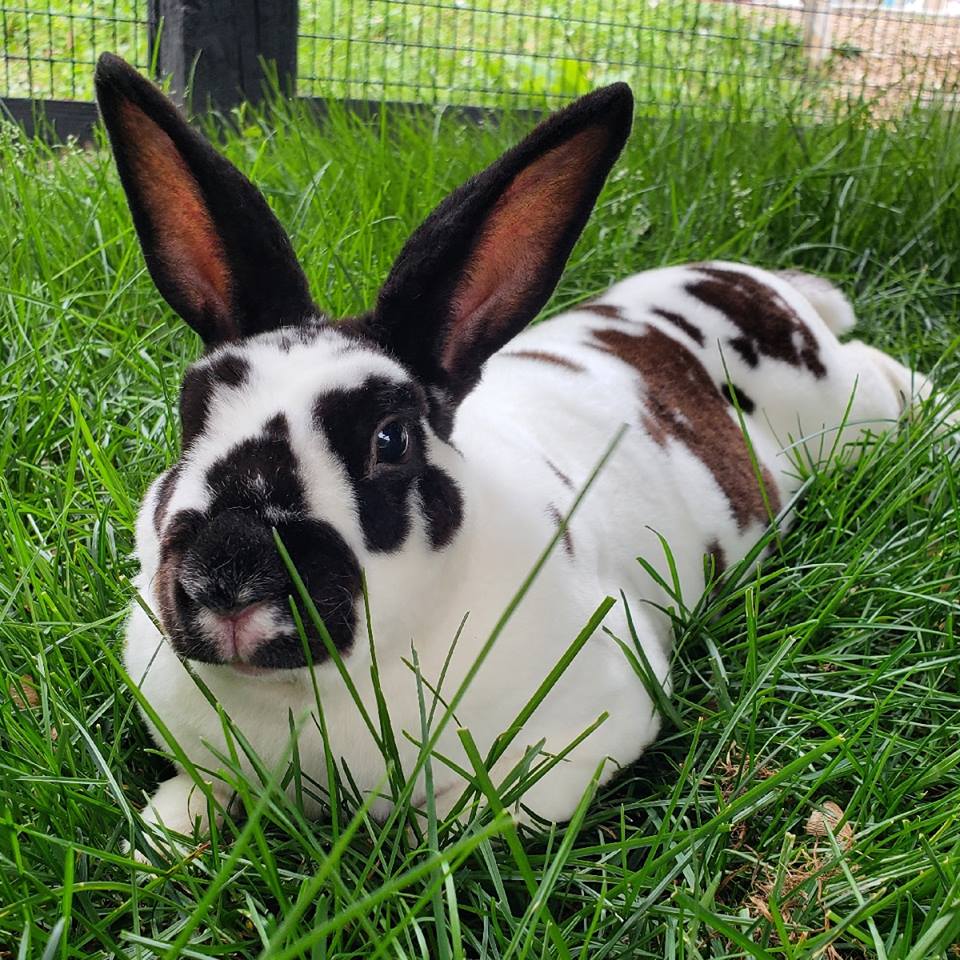

Scientific name
Oryctologus cuniculus domestic rex
Common name
Domestic rabbit, European rabbit
Conservation status
Not evaluated (Domesticated)
Taxonomy
- Kingdom: Animalia
- Phylum: Chordata
- Class: Mammalia
- Order: Lagomorpha
- Family: Leporidae
- Genus: Oryctolagus
- Species: Oryctolagus cuniculus domestic rex
Habitat
(Domesticated)
Geographic range
Domestic
Our Animals Names
Pongo
Favorite enrichment item
Paper products that he can throw around
Life span
In the wild: (Domesticated)
In human care: 8 to 12 years
Diet
In the wild: (Domesticated)
At the Zoo: Purina rabbit chow, greens, produce, and hay
Location in Zoo
Come and see Pongo next time you’re in the Barnyard area, as he’s just a hop away: Right next to the Contact Yard and between Charlotte, our Julianna Pig, and the Playground!
Meet Pongo
Soft, snuggly, and full of sass, Pongo is our resident domestic rabbit here at the Zoo—and he’s ready to charm you with every nose twitch and powerful thump of his back feet! With his velvety Rex coat and signature lop ears, Pongo is always a favorite among guests in the Barnyard area, right between the Contact Yard and Playground.
But don’t let his cute face fool you—Pongo is a great example of just how complex, clever, and misunderstood rabbits really are.
From Wild to Wonderful
While Pongo is very much a domesticated rabbit, his ancestors—the European rabbit (Oryctolagus cuniculus)—were first domesticated around 1,400 years ago in the Mediterranean. Originally kept for meat and fur, rabbits were later bred for companionship and show, resulting in the diverse breeds we see today—like Pongo, who combines the plush coat of a Rex with the signature floppy ears of a Holland Lop.
Rabbit vs. Hare
People often confuse rabbits with hares—but they’re quite different!
| Rabbits (like Pongo) | Hares |
|
|
|
|
|
|
Those Ears Do More Than Flop
Pongo’s big ears are more than just adorable!
Rabbits have evolved ears that can:
- Move independently to scan for predators
- Hear across tall grasses and long distances
- Help regulate body temperature—cooling off in summer and tucking in close in winter to preserve body heat
Not a Rodent!
Even though rabbits have long front teeth and love to chew, they’re not rodents—they belong to a separate order called Lagomorpha.
So, what sets them apart?
- Rabbits have four upper incisors, while rodents have only two
- Rabbits have a small second pair of upper incisors (called “peg teeth”) located right behind the main pair
- Lagomorphs have different jaw structures and digestion patterns than rodents
- Their diets, reproductive systems, and social behaviors also differ in key ways
So, while they may look like cousins, rabbits and rodents split off from a common ancestor millions of years ago, making them distinct, adorable in their own way, and uniquely suited for the plant-packed lives they lead.
What Pongo Eats at the Zoo
Rabbits are herbivores, which means that they consume plants.
In our care, Pongo enjoys:
- Fresh greens & produce
- Purina rabbit chow
- High-fiber hay (alfalfa & timothy)
- Maple-flavored laxative to prevent dangerous hair blockages
Because rabbits groom constantly, they’re prone to GI issues. We help prevent this with regular supplements and vet care.
A Unique Way to Digest
Pongo gets two servings out of every meal thanks to something called cecotropes (also called “night poops”). These soft, nutrient-rich droppings are produced by a special part of the digestive system, pooped out, and re-ingested directly from the source (yep, we said it). This helps rabbits absorb essential nutrients from their plant-heavy diets—just another amazing herbivore superpower!
Paw Power
Did you know rabbits have razor-sharp nails that can easily become overgrown? Overgrown nails can cause pain, injury, and mobility issues, so Pongo gets regular pedicures to keep him hopping safely. It’s just one part of what it takes to give rabbits the care they need to thrive! In the wild
Wild ≠ Domestic
Despite their common origins, wild rabbits and domestic rabbits are very different. Domestic rabbits like Pongo do not have the instincts, camouflage, or survival skills needed to survive outdoors. Sadly, many people mistakenly release pet rabbits into the wild when they’re “done" caring for them, not realizing this almost always leads to the rabbit’s death.
Even worse, these abandoned pets can introduce disease, disrupt native species, and throw local ecosystems out of balance. If you have a rabbit at home that you would like to re-home, please contact your local rabbit rescue.
Never release a domestic animal into the wild—it’s dangerous for them and harmful to the environment.
Fast Facts about Domestic Rabbits
- Domesticated from the European rabbit 1,400 years ago
- Domestic—not found in the wild
- Rabbits are herbivores, and at the zoo, Pongo eats hay, greens, produce, and rabbit chow
- Ever-growing teeth & a special digestive system
- Ears that rotate independently and help regulate body temperature
- Produces cecotropes (night droppings) to re-digest nutrients
- Needs regular nail trims and hairball prevention care
- Can live 8–12 years with proper care
- Never release domestic rabbits into the wild
Conservation Status
International Union for the Conservation of Nature (IUCN) — not evaluated
